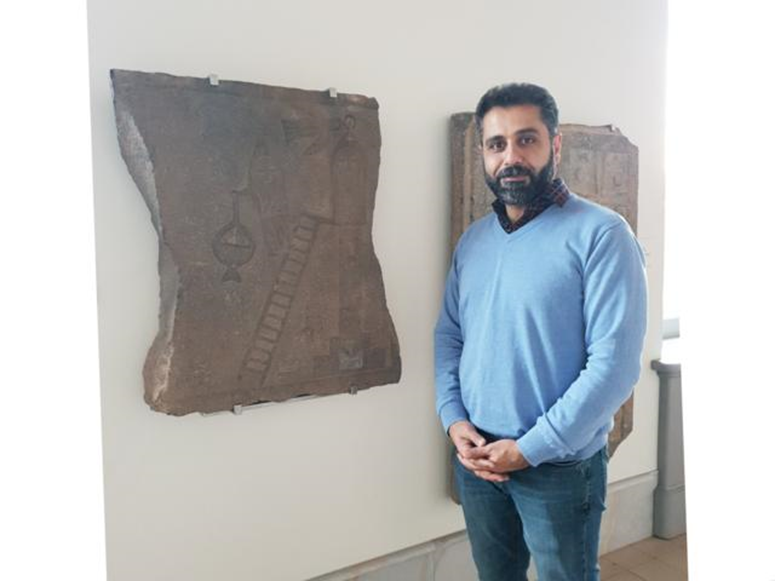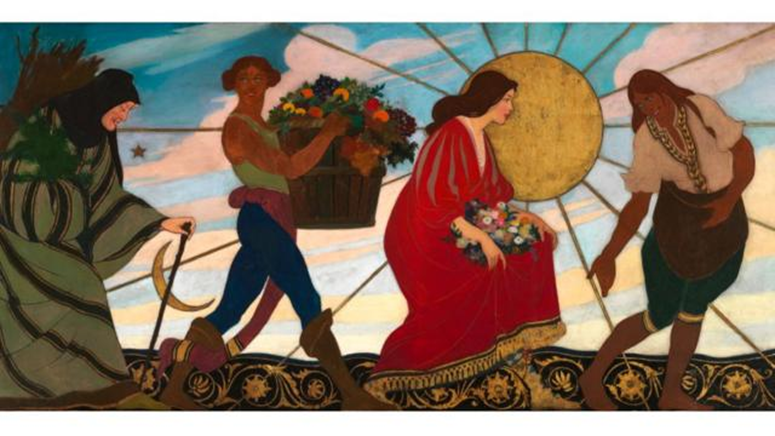The god Tammuz and the myth of eternal love

Image caption: A bronze statue of the god Tammuz/Adonis in the Louvre Museum in France, originating from Lebanon.
The month of July is a month associated with the arrival of summer with all the fertility and maturity of nature that it brings. The name of this month, as the countries of the Arab Levant know it, has a mythical connotation, as its name came from the god of agriculture and grazing (plants and livestock), Tammuz.
Tammuz, the god, has a sad story. Although he belongs to the gods created and chosen by the first man to inhabit the sky, and who are very similar to him, in that he loves, hates, marries, and takes revenge, he differs from him in that he is immortal, but Tammuz, this unique god, was not immortal.
Perhaps the oldest texts that talked about the myth of July are the Sumerian texts that told the story of the god Demuzi (Tammuz) with the goddess Inanna (Ishtar), and later he was mentioned in Babylonian and Assyrian texts.

July in different civilizations
The Syrian writer and researcher, George Kader, author of the book (Dictionary of Pre-Islamic Arab Gods), says: “In ancient inscriptions, the name Tammuz was linked to the name of the Babylonian god Apsu, who was the chief of the gods and the god of waters, and he was referred to as Tammuz Apsu, which means the son of the god.”
Kader points out that Demuzi in the Sumerian nomenclature means the son of the great water god. Tammuz took different names in different civilizations. “He is the Sumerian Demuzi, the Babylonian Tammuz, the Greek Adonis, and the Phoenician Adon, just as he is also Adonis in the Ugarit civilization.”
There is a widespread belief among some researchers that Tammuz was a descendant of the kings of Sumer before what is called the Age of the Flood, and Kader explains the reason behind this belief: “It is likely that the era of King Tammuz was an era of fertility, prosperity, and prosperity. He was immortalized in one of the most important myths of the ancient world, which is the myth of sacred fertility.” .
The myth of love and death
The legend says that the god Tammuz fell in love with the goddess of fertility, love, and beauty, Ishtar. After competing with many of her suitors and courtesans, Tammuz succeeded in convincing Ishtar to marry him.
The two lived in bliss and their house was called the “House of Life,” as this sacred marriage brought together the goddess of love and fertility and the god of grazing and plants (food), thus summarizing the basis of life, hence the name.

Image caption: The story of the Greek god Adonis and the goddess Venus is a similar version of the story of July and Ishtar.
Researcher George Kader explains: “To understand nature and its changes, ancient man resorted to embodying it in human form. The name Tammuz was associated with the name Ishtar to complete the story of sacred marriage. The name Ishtar in ancient languages means (the womb) and is the source of the process of creation. It is natural to approach women and nature, considering that Ishtar (the womb) is the land that gives man its bounties.”
But Ishtar decided to descend into the underworld, and although the reason behind her decision is shrouded in great mystery, some researchers attributed it to her ambition. She wanted to release the dead from the underworld ruled by her sister, “Areshkigal.”

Commenting on the photo, researcher George Kader says, “It is natural to bring women and nature closer together, considering that Ishtar (the womb) is the land that gives man its bounties.”
In an ill-considered adventure, Ishtar placed her crown on her head, carried her famous scepter, wore all her jewelry, and descended into the underworld.
Ishtar descended the seven layers of the underworld, and at each of the seven gates the guards removed some of her jewelry and clothing from her, until she arrived completely naked at the court of Ereshkigal, where she was sitting on her throne surrounded by her seven judges.
The judges of the underworld issued their ruling on Ishtar's death, and she was transformed with a look from her sister into a lifeless corpse.
But Ishtar's loyal minister, Ninchpur, begins a long journey to the great gods to convince them to save his lady. After failed attempts, he reaches the god Enki, the god of wisdom and knowledge. He succeeded in convincing him to save her from the world of the dead.

Enki begins to help Ishtar, so he sprinkles her with the water of life and sprinkles the food of life on her body, so that Ishtar wakes up from her death.
But the judges of Ereshkigal stand guard over her, as this is the world of death and governed by special laws, and it is not possible to return from it, so they issue their ruling that Ishtar must find an alternative to replace her in the world of the dead.
To ensure that Ishtar implemented the decision of the judges of the underworld, the demons of this world accompanied her on a journey to search for an alternative.
After going through a number of potential alternatives, Ishtar chose her husband and lover, Tammuz, to take her place in the underworld. Her decision came after she saw him sitting on her throne, and she did not notice any indication of his grief for her when she died. Ishtar, angry at Tammuz’s indifference, was only to hand him over. For the demons of the underworld.
After desperate attempts to escape from the demons, Tammuz ends up in the underworld, the world of the dead from which there is no return.

But Ishtar regrets her decision when her anger subsides, and she wants to save her lover and husband because the “house of life” has become desolate in the absence of July and he must return for “life” to return.
After a long debate, Ishtar succeeds in convincing the judges of her sister Ereshkigal to allow Tammuz to ascend to earth six months of every year, provided that he spends the other six months in the underworld.
July and the symbolism of the myth
The person’s embodiment of nature in human form is a form of symbolism. Researcher George Kader says: “Humans have deliberately simulated the changes experienced by the seasons and matched them with the human mood. They created many festive rituals to suit the seasons. In the fall, wailing and wailing prevail, imitating the howling winds. In the winter, there are tears, in the spring there is love, fertility, and beauty, and in the summer, birth.
The myth of July and its absence in the underworld for six months a year is nothing but an embodiment of the succession of seasons. Kader adds: “The story of July and Ishtar is the story of life, death, and resurrection again, and their permanent symbolic meeting in the spring gives this season its meanings embodied in fertility, love, and reproduction.”
He goes on to say: “And after birth comes summer, which is the season in which Tammuz dies, embodying the idea of harvesting wheat, that is, cutting the stalks of wheat, and then threshing it.”

He explains: “After the death of Tammuz, man plants that grain of wheat (dry and dead) in the womb of the earth and then it returns to life and becomes a threshing floor, an embodiment of the emergence of life from death, just as Tammuz is resurrected every year from the womb of the kingdom of death in the depths of the earth, and returns to the bosom of Ishtar, the home of Life, and thus the cycle of life is completed, six months in the world of the living (spring and summer seasons) and six months in the world of the dead (autumn and winter seasons).”
Myth and religions
There are connotations in many religions similar to the myth of Tammuz. Researcher George Kader says: “One can notice the echo of the legend of Tammuz in many religions, even heavenly ones. The name Moses means in ancient Pharaonic the one drawn from the water, or to metaphorically say the son of water, and this is in harmony.” With the name of the Sumerian version Demuzi, which means son of the great water god.”
The royal mummies' journey from death to "immortality" in ancient Egypt
He added: “As for Christianity, the idea of redemption and salvation clearly intersects with the myth of July. Christ (the Son of God in Christian belief) redeems humans by offering his body (bread) and blood (wine) as their symbols, to atone for the sins of humans. He dies and then rises from the dead.” Death on the third day of his crucifixion so that life could continue, just like July, which dies and returns to life in the cycle of cosmic renewal.”

Image caption: The Four Seasons as depicted by American painter William Clark Rice (1923).
In Islam, Kader believes that the tragedy of Hussein, the grandson of the Prophet Muhammad, and the accompanying rituals of mourning and lamentation are very similar to the rituals of mourning and lamentation for the god Tammuz in ancient mythology.
Thus, the legend of the love of July and Ishtar is completed, imbuing with its fluctuations the fluctuations of the seasons of the year, and being reduced to a wonderful epic that renews the eternal cycle of nature from annihilation to life.
Source: websites

